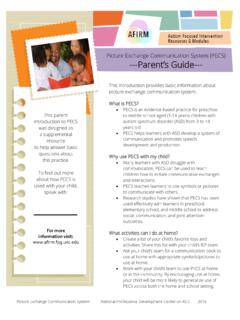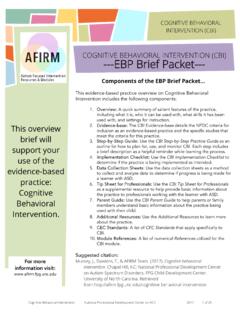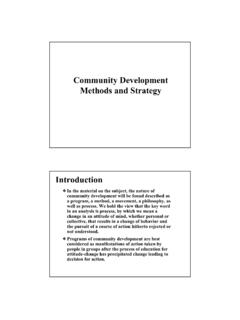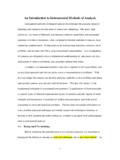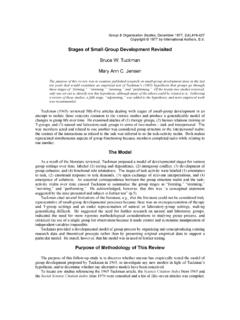Transcription of Task Analysis (TA) ---Step-by-Step Guide---
1 Task Analysis National Professional development Center on ASD 2015 1 This practice guide outlines how to plan for, use, and monitor the task Analysis practice. Keep in mind that the three task Analysis procedures are: Forward chaining Backward chaining Total task presentation While each procedure is different, the practice guide is applicable to all. When unique features are tied to a specific procedure, we will identify them through examples or cautions. BEFORE YOU Each of the following points is important to address so that you can be sure the selected EBP is likely to address the learning needs of your student. Have you found out more information about..? Identified the Collected baseline data through direct Established a goal or outcome that clearly states when the behavior will occur, what the target skill is, and how the team will know when the skill is If the answer to any of these is no, review the process of how to select an EBP.
2 For more information visit: Task Analysis (TA) ---Step-by-Step Guide--- Task Analysis National Professional development Center on ASD 2015 2 Now you are ready to Step 1: TA Planning The planning step explains how to identify the components of the target skill or behavior, select an appropriate task Analysis procedure, and determine methods for teaching steps of the task Analysis . Determine if learner has prerequisite skills needed to learn target skill/behavior Review collected data to determine if the learner has the perquisite skills needed for the target skill or behavior. If the learner does not have the prerequisite skills, these skills will either need to be incorporated into the steps of the task Analysis or taught before proceeding with the task Analysis . Identify the components of the target skill/behavior Break down a target skill or behavior into smaller steps by: Watching someone competent in completing the target skill/behavior complete the task.
3 As the person completes the task, write down each step. Asking an expert in the target skill or behavior to record each of the steps. Completing the task yourself and record each of the steps. Check if task is completely analyzed Check to determine if the steps are accurate by performing the target skill or behavior again and following each of the steps. Make sure: Each step is a discrete behavior, The steps are manageable for the learner, and The steps are described accurately for the learner s needs. Select appropriate task Analysis procedure Team members will decide what procedure they will use for chaining the identified steps: forward chaining, backward chaining, or total task. Select appropriate method for teaching steps of the TA To teach the determined individual steps, team members will need to select additional evidence-based practices. Prompting, time delay, and reinforcement are commonly used practices to teach the smaller steps.
4 Develop presentation materials of the steps Consider the strengths and needs of the learner with ASD to determine how the steps of the task Analysis should be presented to the learner. The steps of the task Analysis can be presented with pictures, text, or video. Task Analysis National Professional development Center on ASD 2015 3 Step 2: Using TA This step describes the process of using each of the task Analysis procedures. Follow the unique steps for backward chaining. When backward chaining is used to teach a target skill or behavior, the steps identified in the task Analysis will be taught in reverse order beginning with the final step. Follow the steps outlined below: Provide assistance to learner with completing the initial identified steps. Prompt learner to perform the final step. Remember, to select the prompting procedure (least-to-most prompting, graduated guidance, or simultaneous prompting) that would best assist the learner in understanding what is expected.
5 Also, be sure to use visual supports if appropriate. Reinforce the leaner for completing the final step. When the final step is mastered, the previous step is added one at a time. Use the Graduated Guidance Response Diagram to guide your response to learner s attempts. Use the Least-to-Most Response Diagram to guide your response to learner s attempts. Use the Simultaneous Prompting Response Diagram to guide your response to learner s attempts Follow the unique steps for forward chaining When forward chaining is used, an adult begins by teaching the first step in the chain. As each step is mastered, the next step in the task Analysis is then taught. Follow the steps outlined below: Prompt the learner to perform the first step identified in the task Analysis . Use the selected prompting procedure (least-to-most prompting, graduated guidance, or simultaneous prompting). Be sure to use any additional created materials such as a video for video modeling or visual directions that could assist the learner in performing the skill/behavior.
6 When learner completes the step, reinforce the learner with social praise and a tangible reinforcer if appropriate. After the first step is completed, guide the learner through the remaining steps. When the first step is mastered, the next step in the task Analysis is added one at a time. Follow the unique steps for total task presentation For total task presentation, the learner is taught the entire task including each individual step until the chain is mastered. Follow the steps outlined below: Use a prompting procedure (least-to-most prompting, graduated guidance, or simultaneous prompting) and visual supports or video modeling to assist the learner in performing each step of the task Analysis . Reinforce the learner for completing each step. Be sure to save the most effective reinforcer for the final step when the entire skill/behavior has been performed. Fade reinforcers as quickly as possible. Task Analysis STEP-BY-STEP Task Analysis National Professional development Center on ASD 2015 4 Step 3: Monitoring TA The following process describes how the use of task Analysis can be monitored and how to adjust your plan based on the data.
7 Collect data on target behaviors Collect data on target skills and behaviors. Be sure to include the level of support needed for each of the steps identified for the task Analysis . Use the TA Progress Monitoring Form to collect data. Determine next steps based on learner progress If the learner with ASD is showing progress with task Analysis based upon collected data, then continue to use this practice with the learner. Consider using task Analysis to address new target skills or behaviors with the learner. If the learner is not showing progress, ask yourself the following questions: Is the target skill or behavior will defined? Is the target skill or behavior measurable and observable? Does the learner have the prerequisite skills needed to learn the skill/behavior? Was the task completely analyzed? Was an appropriate teaching method selected to teach the individual steps of the task Analysis ? Was task Analysis used with fidelity based upon the implementation checklist?
8 Was the learner prompted to perform the individual step? If these issues have been addressed and the learner with ASD continues not to show progress, consider selecting a different evidence-based practice to use with the learner with ASD. Task Analysis STEP-BY-STEP

